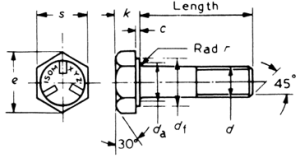Capacities of Bolts and Welds to BS449: Part 2

Description
BS 449: Part 2 is a British standard that provides guidelines for the structural use of steel. It includes specifications for the capacities of bolts and welds used in steel connections. The capacities are determined based on the type of bolt (ordinary, countersunk, or high-strength friction grip) and the type of weld (fillet).
-
Bolts: a. Ordinary Bolts: The capacity of ordinary bolts is determined by their shear and tensile strengths. The shear capacity is calculated based on the bolt's diameter, while the tensile capacity is determined by the bolt's cross-sectional area and the ultimate tensile strength of the bolt material.
b. Countersunk Bolts: Countersunk bolts are used when a smooth surface is required on the connected parts. The capacity of countersunk bolts is also determined by shear and tensile strengths, similar to ordinary bolts. However, the capacity calculations consider the reduced effective area due to the countersinking.
c. High-Strength Friction Grip (HSFG) Bolts: HSFG bolts are designed to provide high clamping force through friction between the connected parts. The capacity of HSFG bolts is determined by both their shear and tension capacities, which are influenced by the bolt diameter, thread pitch, and the specified coefficient of friction between the connected surfaces.
-
Welds: Fillet welds are commonly used in steel connections. The capacity of fillet welds is determined based on their effective throat thickness and the ultimate shear strength of the weld material. The effective throat thickness is a function of the leg lengths of the fillet weld.
To find the specific capacities of bolts and welds to BS 449: Part 2, you need to refer to the standard itself. It provides detailed tables and formulas for calculating the capacities based on the bolt type, weld type, and relevant dimensions.
It is important to note that the standard may also provide additional requirements and considerations for the design and installation of bolts and welds, such as edge distances, end distances, and proper detailing practices.
Dr Shaiq Khan is a Chartered Structural Engineer working freelance in the building trade. In his day to day work, he develops and uses computer software for the design and maintenance of buildings. This enables him to enhance the quality of work for his clients. It also shares and enhances technical expertise with fellow professionals in this country and abroad. More details at his website.
Calculation Reference
Bolt Analysis
Calculation Preview
Full download access to any calculation is available to users with a paid or awarded subscription (XLC Pro).
Subscriptions are free to contributors to the site, alternatively they can be purchased.
Click here for information on subscriptions.

